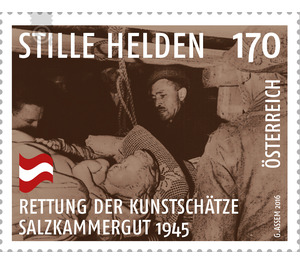rescue - Austria / II. Republic of Austria 2016 - 170 Euro Cent
Theme: History & Politics
| Country | Austria / II. Republic of Austria |
| Issue Date | 2016 |
| Face Value | 170.00 |
| Edition Issued | 170,000 |
| Printing Type | offset |
| Stamp Type | Commemorative |
| Item Type | Stamp |
| Chronological Issue Number | 2626 |
| Chronological Chapter | OOS-OE2 |
| SID | 634186 |
| In 72 Wishlists | |
Not only Austria, but the whole world thanks: In the last days of the war in the spring of 1945, valuable art treasures stored in the tunnels of the salt mine Altaussee were saved from annihilation by courageous civilians in a dramatic rescue operation. From 1943 until the end of the Second World War, Adolf Hitler had paintings, sculptures and other works of art, which the Nazi regime had acquired in different ways in his possession, stored in the safe and hidden tunnels of the mine. Some of these art treasures were intended for the Führer Museum, which Hitler wanted to build in Linz. Not only from Austria, but from many other European countries came the works - many from confiscated Jewish art collections or compulsory sales, others simply from looting in occupied territories. World-famous paintings by artists such as Vermeer, Rembrandt, Titian, Raphael, da Vinci, Rubens or Brueghel were stored in empty mine shafts in simple shelves, often wrapped in blankets as makeshift as packaging material was scarce. One of the most valuable pieces was the Bruges Madonna by Michelangelo, a marble sculpture that Nazi troops had taken from the Church of Our Lady of Bruges in Bruges - it was also intended for the Fuhrer Museum. The 15th century Ghent altarpiece by Jan van Eyck is another famous work of art that was stolen and stored in the tunnels. In the final phase of the war in April 1945, when a defeat was already foreseeable, the Gauleiter of Oberdonau August Eigruber made the decision under all circumstances to avoid that the art treasures fell into the hands of the victorious powers. He had eight aerial bombs, each weighing 500 kilograms, brought into the tunnels to destroy all works of art by blowing them up. This plan caused horror - with art experts as well as with the miners who feared for their mine and their existence. With the help of SS functionary Kaltenbrunner, the miners succeeded in creating the bombs from the tunnels and closing the entrance to the galleries with blasting. The US "Monument Men", a special unit to rescue Nazi looted art, were finally able to recover the artwork, which was then returned to their respective owners.


